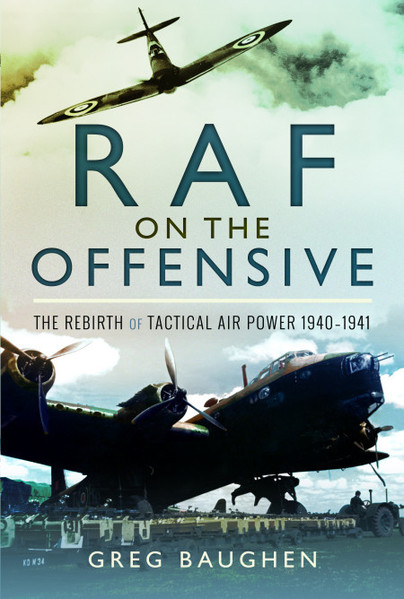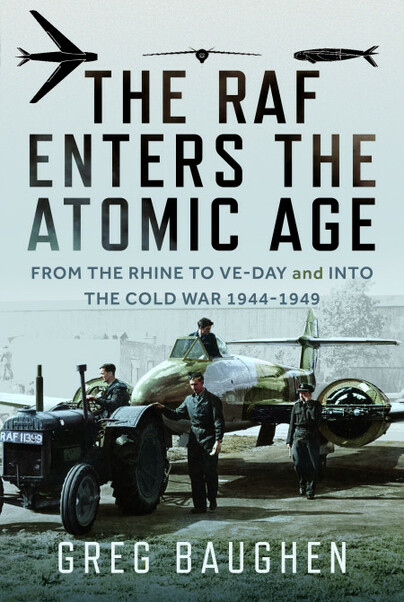RAF On the Offensive (Hardback)
The Rebirth of Tactical Air Power 1940–1941
History Hit
'How Britain's Air Policy in 1941 Gambled with the Country's Future' – an article by Greg Baughen for History Hit.
(click here for international delivery rates)
Order within the next 9 hours, 56 minutes to get your order processed the next working day!
Need a currency converter? Check XE.com for live rates
| Other formats available - Buy the Hardback and get the eBook for free! | Price |
|---|---|
| RAF On the Offensive ePub (7.4 MB) Add to Basket | £6.99 |
Long before the start of the Second World War it had been believed that strategic bombing would be the deciding factor in any future conflict. Then Hitler launched the Blitzkrieg upon France and the Low Countries in 1940, and the much-vaunted French Army and the British Expeditionary Force were swept away in just six weeks.
This new form of warfare shook the Air Ministry, but the expected invasion never came and the Battle of Britain was fought in the air. It seemed that air forces operating independently could determine the course of the war. An Army scarcely seemed necessary for the defence of the UK and no British army could ever be powerful enough to mount an invasion of Europe on its own. Bombing Germany into defeat seemed Britain's only option. In North Africa, however, Commonwealth armies and air forces were demonstrating that they too could use blitzkrieg tactics to crush opponents. Britain was also no longer alone; Greece and then the Soviet Union joined the fight.
RAF on the Offensive describes how British air power developed after the Battle of Britain. Attitudes were beginning to change – the fighter, rather than the bomber, was re-emerging as the principal means of gaining air superiority. As 1941 drew to a close, the strategic air offensive appeared to be achieving little and conventional land warfare seemed poised to replace it as the way to defeat the enemy. Which direction, then, would the war take? Aviation historian Greg Baughen uses his vast military aviation knowledge to explore the topic.
Information packed, a lot of which will be new to many readers. It gives an enlightening look at the RAF through a year of the war that saw many changes in aviation and aerial combat.
Vintage Airfix
Read the full review here
The author does a good job of tracing how attitudes began to change at the higher levels of the RAF (at least for some), with Portal in particular coming to realise that more fighters were needed in just about every theatre, while increasing evidence of the failure of Bomber Command’s night bombers to actually hit their targets forced a re-evaluation of the RAF’s role. This is a good study of how the RAF begrudgingly began to work on providing close support for the army, and almost accidentally found itself with good fighter bombers, all of which would pay off in 1944.
History of War
Read the full review here
Baughen’s book follows a two track narrative; one, the development of the technology, doctrine and tactics around close air support and the second, and more surprising, the challenges in adjusting the engrained paradigm of the primacy of the bomber amongst the RAF leadership. This engaging and balanced work dispels the myth of united and visionary RAF leadership readily adapting to the lessons of the Battles of France and Britain, revealing instead a deeply divided and political entity, intent on maintaining its independence from the Army and Navy. The reasons behind and the development of a highly effective close air support capability, rounds out this excellent study.
The Military Reviewer
Read the full review here
Greg Baughen has been researching military aviation for as long as I have been researching the British Army, and this is latest scholarly edition to our bookshelves. September 1940 saw the launch of the German's 'Blitz' against Britain, followed by the RAF's response against Germany and the Axis powers.
Paul Nixon
2020 marks the 80th anniversary of the Battle of Britain and the start of the Blitz, and so the timing of this book (2018) is appropriate and relevant. The numerous footnotes referencing original documents at the National Archives only adds to the the confidence in this treatment of this subject.
Read the full review here
As I started off this book is very detailed and comprehensive with much detail fitted into the book, it is clear from looking at the author’s background he has an excellent background in military aviation and clearly knows his stuff about airforce’s. I’ll just say that his style of writing clearly shows that he specialises in mathematics... I would recommend this book and happily give it a 4.5 star rating.
UK Historian
Read the full review here
I am always interested in the war in the air and this book gave me details I have not read before.
Richard Domoney-Saunders
It is packed with new information and is written in a style that opens up alot for the reader.
If you are interested in the air war then this is a book that must be added to your library.
The author has produced a detailed view of how the RAF addressed a serious deficiency to build an impressive tactical air power. The RAF had neglected tactical air power, leaving the Army exposed and, without urgent correction, landing troops in Occupied Europe successfully would be impossible. – Very Highly Recommended.
Firetrench
Read the full review here
Video review on Scale Modelling Now
Scale Modelling Now
This was an entertaining and informative read and made me think a bit more in-depth about how WWII was fought.
GoodReads, Robert Neil Smith
Read the full review here
As featured on Chiznoids via Instagram
Chiznoids
Baughen also does a good job (to a point) of showing the divisions within the Air Ministry and RAF both at home and abroad and their impacts.
Air Power History
An interesting book on this topic.
Fliegerblatt, 3/2019
A book of outstanding scholarship which should be read not just by air-enthusiasts but also every member of today’s armed forces!
Shackleton Association, 2019
Excellent book! It describes the struggle between the RAF Air Staff and the War Office (Army) regarding tactical air or close support / battlefield air power. The author also discusses the Air Staff’s obstinate efforts to defend the doctrine of “Strategic Bombing” in defiance of all the evidence that it accomplished nothing. Germany conquered half of Europe in 1940 / 1941 with the combination of mobile armored forces in conjunction with ground support from the Luftwaffe yet the RAF persisted in thinking that this was an aberration and an incorrect use of air power. The incredible overestimation's and exaggerations of the effects of supposed “strategic bombing” on German industry are clearly described. In 1939 – 1941 most RAF bomber crews couldn’t even find Cologne or Essen let alone find an individual factory within those cities.
Amazon.com review
Chapter 11 “Butt Bombshell” describes the effects of the renowned Butt Report on British thinking: only 1/3 of the bombs dropped fell within 5 miles of the target. In the Ruhr industrial target area, only one in ten bombs fell within this 5 mile accuracy criterion. As stated on page 212, “Rarely in the history of warfare can so much have been invested in the development of a strategy that produced so little military gain.”
I have always found it amazing that strategic bombing advocates, both civilian and military, have always been able to deceive themselves about the effectiveness of bombing on an enemy’s ability and will to resist. For more than a century now, from WW I, WW II, and Vietnam to Afghanistan and so forth, these people always manage to persuade themselves (and quite a few others) that bombing will “win the war.” It is a perfect example of the triumph of fantasy and wishful thinking.
An excellent related book on this subject is “Blueprint for Victory” by Baughen (2014). It describes the development and evolution of Britain’s Royal Flying Corp (RFC) in the World War I era 1914 – 1918. It particularly describes the technical development and evolution of the RFC airplanes and the evolution of the tactics associated with supporting the British Army via ground attack (“close air support” in today’s military lexicon, I believe). The author also discusses the diversion of effort to the mystical strategic bombing fantasies in 1916 or 1917 through 1918 – the same arguments preceding those of 1939 – 1941.
Greg is masterful at drawing out and showing the almost uniquely British parochial and bureaucratic approach to issues which continues to operate despite the war and the desperate circumstances the country found itself in. The ability to give short shrift to air force dogma is also welcome.
Amazon Customer
Read the full review here
This is the fourth of Greg's books that I've read and I'm yet to be disappointed. I don't agree with all that he says but any writing that stimulates thought and discussion is worth reading in my book: no pun intended.
Amazon Customer
Read the full review here
About Greg Baughen
GREG BAUGHEN was educated at Sussex University where he obtained a degree in Mathematics. In a varied teaching career, he has taught Maths and English as a foreign language, to children and adults, in Britain and abroad. His interest in military aviation was sparked at a very early age by curiosity over the defeat of British and French air forces in the Battle of France in 1940. For forty years, he has delved though public archives in Britain and France seeking explanations. The quest has taken him back to the origins of air power in both countries and forwards to what might have been in the Cold War. He then set to work writing a history of air power in both countries.
The RAF Enters the Atomic Age From the Rhine to VE-Day and into the Cold War, 1944-1949 (Hardback)
By September 1944 the Western Allies had reached the approximate positions they had held back in September 1939 at the outbreak of war. It had taken more than four years to claw back the territory lost in 1940. It was four years in which the strategic bomber had failed to deliver the victory the bomber advocates had promised. With Allied armies converging on Germany from all directions, they were running out of time to prove that countries could be bombed into defeat. Baughen describes the fierce battles that were fought right up to the German surrender in May 1945. He also explores the equally…
By Greg BaughenClick here to buy both titles for £45.00


















